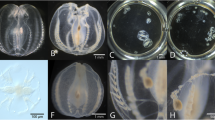Abstract
MARINE plants and animals required for identification or anatomical studies are usually preserved in a 70 per cent aqueous solution of ethyl alcohol or in a 2–4 per cent solution of formaldehyde (5–10 per cent formalin). The great disadvantages of ethyl alcohol are that it volatilizes very readily, it tends to produce precipitates from sea-water, and it causes shrinkage of many species. Although formalin evaporates less rapidly than ethyl alcohol, precautions to prevent desiccation are still necessary; it has the further disadvantage that it tends to oxidize to formic acid, which may dissolve calcareous structures, and it has a very strong smell.
Similar content being viewed by others
Author information
Authors and Affiliations
Rights and permissions
About this article
Cite this article
WILLIAMSON, D., RUSSELL, G. Ethylene Glycol as a Preservative for Marine Organisms. Nature 206, 1370–1371 (1965). https://doi.org/10.1038/2061370a0
Issue Date:
DOI: https://doi.org/10.1038/2061370a0
- Springer Nature Limited





